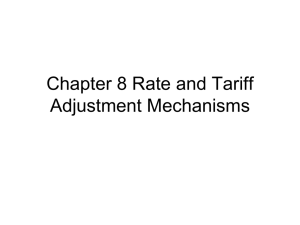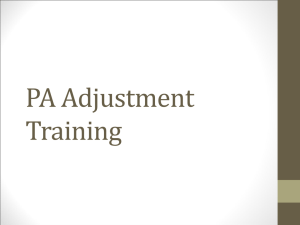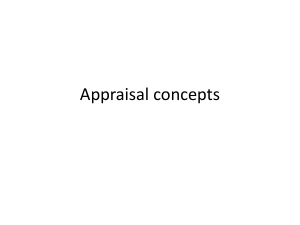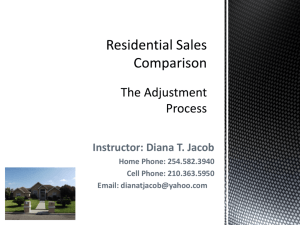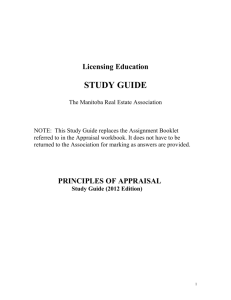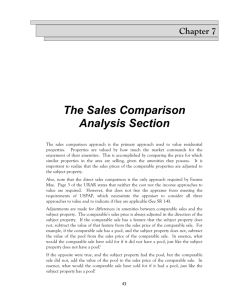Sales Comparison Approach
advertisement
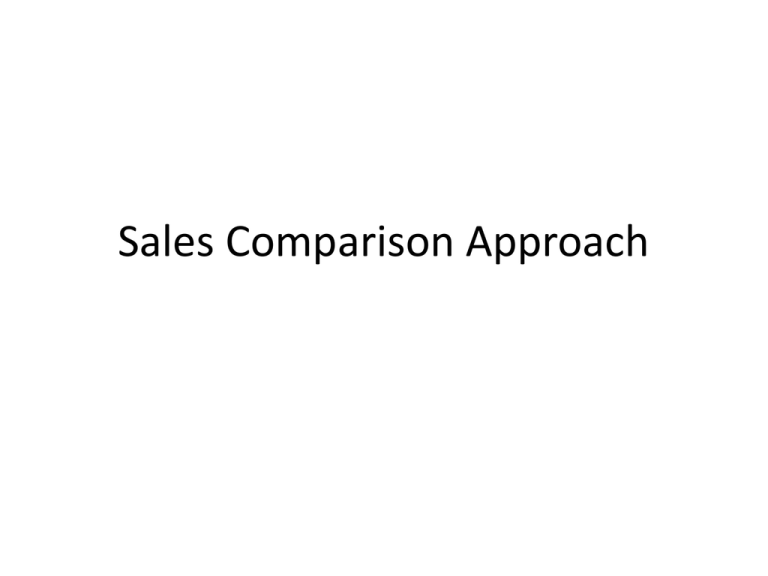
Sales Comparison Approach • The most important part of an appraisal is the analysis of the market data available • The market is telling you what people are willing to pay for land in a given circumstance • Improved and unimproved sales • What you are looking for is a sale with a single land class or something that you can use as the basis for making the comparisons Appraisal principles • Supply and demand; remember that the appraisal is made at a specific time and you have to know the effective demand and the supply of properties • Substitution; REMEMBER the value of the property is set by the price paid to acquire a substitute property; changed by special circumstances and the appraiser has to be aware of these Appraisal principles • Externalities; neighborhood, services; roads, access to markets, … • Balance; appraiser has to constantly stay in touch with what is happening not only in the neighborhood but throughout the industry Approach • Obtain information on sales, listings and offers for all properties similar to the subject • Verify that information; too many tall tales with respect to land; be aware! • Get the right unit for comparison; dollars per acre; per square foot; other • Compare the subject property and the comparable sales and adjust the price of comparables as needed or eliminate them • Reconcile the values from the comparables into a single value or range of values Elements of comparison • Property rights conveyed; if there are leases and other encumbrances on the property and the desire is for a fee simple appraisal then adjustments may be necessary to make the subject and the sale the same; this adjustment should be done first • Financing; the terms of the sales can have an impact on the price that is paid; appraisal should be adjusted to cash or cash equivalency basis for the appraisal Financing adjustments • Assume we have a 160 acre farm that sold for $600,000 with a $120,000 down payment and the seller financed the mortgage of $480,000 for 20 years at 5%. The market interest rate was 8%. The 20% down and the 20 years are within market parameters so only the low interest rate needs to be considered. • $480,000 mortgage at 5% for 20 years has a payment of $38,516 per year. • The present value of $38,516 for 20 years at 8% is $378, 156. • $378,156 + $120,000 = $498,156 cash equivalent price • $600,000 - $498,156 = $101,844 or $637 per acre adjustment Financing adjustment • Appraiser has to be careful in how they do this and what values they assume. • If a financing adjustment is made it should be the second adjustment made Condition of the sale adjustments • This can be a sale under duress or a sale as settlement of a divorce or something similar where there is a need for the sale. • Sale to a relative; • Purchase because of some special reason (sentimental) • All these factors can influence the price paid • It is best to not use such sales as a comparable but if you have to then be careful; this should be the third adjustment Market condition adjustment • This is the basic idea that times changes and so do market conditions. Remember that the appraisal is made as of a specific date • If conditions have not changed then there is no need for an adjustment, in other words don’t change the comparable simply to change it for time • This should be the fourth change made Location adjustment • This can be a major difference depending on the circumstances (3 most important things in determining the value of a piece of property) • Roads, markets (ethanol plant, river, rail lines, etc. ) • Urban centers ( farming opportunities, highest and best use) Physical characteristics • • • • • • Land type ratios Ranges Land quality Timber Slope Percent tillable Types of adjustments • Percentage – 1) Subject equal to comparison; no adjustment – 2) When presented as “subject is…” then use multiplication – 3) When presented as “the comparable is…” then use division • Subject is 10% superior to the comparable – Multiply the price of the comparable by 1.1 to estimate the value of the subject. % adjustment to the price of the comparable is plus 10% • Subject is 10% inferior to the comparable – Multiply the price of the comparable by .9 to estimate the value of the subject. % adjustment to the price of the comparable is minus 10% • Comparable is 10% superior to the subject – Divide the comparable by 1.1 to estimate the value of the subject. % adjustment to comparable is minus 9% • Comparable is 10% inferior to the subject – Divide the comparable by .9 to estimate the value of the subject. % adjustment to comparable is 11% Adjustments • The key is to be consistent; don’t mix comparable to subject, and vice versa • Dollar adjustments; Most common; dollars are added to or subtracted from comparable to obtain the value of the subject Paired analysis • Provides market evidence for amount and direction of a particular adjustment • Pair only two sales for the adjustment and check them against other sales • Appraiser has to use some judgment “but judgment without market evidence is simply not acceptable appraisal practice.” Impact of a paved road; Sale A on paved and Sale B on dirt Sale A Sale B $800 $750 160 160 • Selling price • Acres • Financing Cash Cash • Market conditions Current Current • Size 0 0 • Location ? ? • Land 0 0 • Buildings 0 0 • Adjusted price $800 $750 Paired Comparison • $50 per acre impact from the paved vs dirt road • Appraiser will keep checking this amount as they find sales that let them make the comparison • Once one adjustment has been ‘proved’ in the market it can be used for other comparisons • Assume two similar sales except location and size Size Comparison • • • • • • • • • Selling price Acres Financing Market Size Location Land Buildings Adjusted price • Sale C Sale D $700 320 Cash Current ? -$50 0 0 $650 $750 160 Cash Current ? 0 0 0 $750 Size comparison • Adjustment is $100 per acre assuming that the adjustment of $50 for location holds • Next is time adjustment • Remember with time adjustment that the percentage adjustment is a reflection of compounding too • Sale two years ago at $1000, next year at $1,100 and this year at $1,200 What’s the percent change due to time? Market conditions (time) • • • • • • • • • Selling Price Acres Financing Market conditions Size Location Land Buildings Adjusted Price • Sale E Sale F $780 320 Cash Current $100 0 0 0 $880 $950 150 Cash 1.5 yrs. 0 0 0 0 $950 Market conditions (time) • What is the percentage change due to time? – $880 - $950 = -$70 • -$70/950 = -7.4%/1.5 = -4.9% • Sale 1 yr. ago for $600,000 • Sale this yr. for $742,000 but property had $65,500 in improvements Comparison • Sale A: 160 Ac. on Hyw. 6, two miles from Growthville, all Class II soils, no improvements, sold 1 year ago for $1,200, Cash • Sale A • • • • • • • Price $1,200 Acres 160 Financing Cash Market 1 yr. Location 2mi. Land 0 Improvements 0 Sale B Sale C Sale D $1,000 $860 $905 140 180 150 Subject 160 Cash Loan Cash Cash Now Now 1yr. Now 4 mi 6 mi. 7 mi. 6 mi. 0 0 0 0 0 • 5% decrease in land values over past year 0 0 0 Steps • First thing to do is to find a control sale. This is the sale as similar to the subject property as possible. • Comparisons will be made to this sale • Assume that we are interested in finding the market contribution of location using these sales. • Time adjustments have to be made first • Which is the most like the subject? Pairs for Location • Sale C • • • • • • • • • • Selling Price $860 Acres 180 Financing Cash Market conditions Current Size 0 Location 6 miles Land 0 Buildings 0 Adjusted Price $ Difference due to location Sale A $1,200 160 Cash 0 2 miles 0 0 $ Pairs for Location • Sale C • • • • • • • • • • Selling Price $860 Acres 180 Financing Cash Market conditions Current Size 0 Location 6 miles Land 0 Buildings 0 Adjusted Price $ Difference due to location Sale B $1,000 140 Cash Current 0 4 miles 0 0 $ Pairs for Location • Sale C • • • • • • • • • • Selling Price $860 Acres 180 Financing Cash Market conditions Current Size 0 Location 6 miles Land 0 Buildings 0 Adjusted Price $ Difference due to location Sale D $905 150 Cash 0 7 miles 0 0 $ Improved land • Appraisal of improved land starts with determining the value for each land class through evaluating sales of unimproved land • These land classes will then be used to determine the value of the land to the sale and the residual will be the value of the improvements • The value of the improvements will then be allocated among the buildings, etc. Value of the land classes • Assume that the appraiser knows that unimproved sales indicate this division for each land class – Class I – Class II – Class III 100% 60% 40% • What is the value of each land class if we had a sale for $260,000 with 100 acres of Class I, 200 acres of Class II and 100 acres of Class III. Land class example • • • • • • Class I 100%, Class II 60% and Class III 40% 100 ac. Class I, 200 ac. Class II, 100 ac. Class III $260,000 sale price 100 * 100% = 100 200 * 60% = 120 100 * 40% = 40 260 $260,000/260 = $1,000 Class I $1,000 * .60 = 600 Class II $1,000 * .40 = 400 Class III

